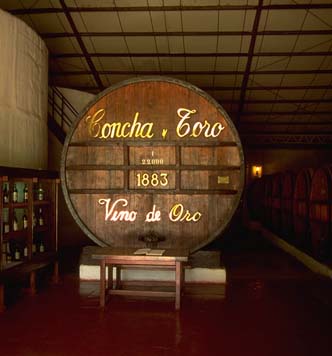
Chile’s Concha y Toro Winery
Ok, what’s purple and lives in Chile? Cabernet the grape and he probably hangs out at Vina Concha y Toro, Chile’s largest winery.
A visit to Concha y Toro Winery comes as a pleasant surprise to tourists overwhelmed by Santiago's LA-like sprawl. The winery, situated in the lovely village of Pirque near the foothills of the Andes, can be reached after a 45-minute van ride from central Santiago.
Although Vina
Concha y Toro is Chile's largest winery, producing over 50 million liters of
wine per year, the original winery at Pirque retains much of its 19th century
charm. A stucco wall capped with red tile winds it way though the village and
forms the perimeter of the original estate. Inside the walls are the winery,
the original hacienda and 100 acres of hardscrabble -- perfect for Cabernet
Sauvignon.
In fact, much of central Chile is good for grapes. The region enjoys a mild Mediterranean climate and has enough soil types and micro climates that wine makers can pick and choose their vineyard locations at will. "... and the Cordillera of the Andes presents a natural barrier to the vine disease Phylloxera," says Vina Concha y Toro spokesman Marco Fredes.
The winery was founded in the 19th century when Don Melchor Concha y Toro, a young lawyer, married into the up-scale Subercaseaux family. As luck would have it, the Subercaseauxs owned most of the Maipu River Valley south of Santiago. Soon the new son-in-law was busy importing grapevines from Europe and planting them in the gravely soil.
The rest is wine history. Vina Concha y Toro grew into the present giant, turning grapes into good wine from over 12,000 acres in Central Chile. Their Cabernet Don Melchor (named after you-know-who) pulls down a 92 rating from those who judge such things.
Visitors who want to tour the winery and sip a little Don Melchor can make arrangements through any three-star or better hotel in downtown Santiago. If enough people show, a tour van appears. Otherwise, a taxi works just fine. Of course, those with a sense of adventure can always take a city bus.
The tours start at 10:00AM then closes around 1:00PM for siesta. At 4:00PM, they open for the late afternoon trade.
Things get underway at the guard house by the big wrought iron gate. While waiting for the tour to begin, one can check out the beauty of the place -- the Spanish architecture against Chile's Araucaria pines and, of course, the Andes in the background.
Once inside the winery, the English speaking guide begins the tour in a building crowded with huge wine casks as big as houses. One 22,000 liter giant, complete with a polished brass Vina Concha y Toro logo, is the centerpiece of the winery. It's dark and cool among the giant casks. The air is pungent with the scent of fermentation. The brick floor with its thin layer of sand crunches underfoot. Everything seems to have its place in the scheme of wine making.
Those big rooms with their wooden barrels are a natural for photos, and flash photography is permitted. Visitors carried away with their photography and fall behind can easily pickup the next group.
All tours make their way down a flight of stone steps to the "Devil's Cellar," and therein lies a tale.
As the guides tell it, Don Melchor (remember him?) discovered that the workers were getting into his private stock and partying down. To stop this mischief, the Don started the rumor that the devil occupied the cellar where he kept his stock. The Don even dressed in a devil suit and acted out the part. Now, whether the workers were truly routed or simply walked away, embarrassed for the Don, it is not known. What is known is that the private reserve, now called Casillero del Diablo, is the most famous product of Vina Concha y Toro.
Once in the cellar, visitors can peer through a dungeon-like iron grating to the oaken casks and bottles containing the award winning wine. "Those oaken barrels are from Lebanon, Missouri in America," says David Chacon, Chief of Technical Operations. Senor Chacon is proud of the American connection and enjoys telling how the barrels from the show-me state are a superior product.
Visitors are surprised to see that some of the great wooden vats that hold the varietal wines are being replaced by stainless steel tanks which lend themselves to the production of light wines for export. America's new found love affair with wine does not go unnoticed at Vina Concha y Toro.
After leaving the new facilities, visitors are ushered out back to the Cabernet Sauvignon vineyard that is reserved for Casillero del Diablo. Vines work hard in that field, yearly producing over 300,000 liters of wine for the Devil's Cellar.
On the way back from the vineyard, visitors stop at the winery museum where the story of Vina Concha y Toro is played out through interesting old photographs, ancient wine presses, and cases full of hard-won medals.
Finally, as with all good winery tours, visitors are ushered to the tasting room where for about a dollar, each can sip a glass of Don Melchor. Visitors compare palates with those of the experts and perhaps decide that -- yes, Don Melchor does have "... a hint of wild berry with a subtle undertone of chocolate."